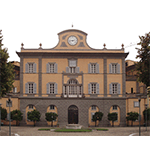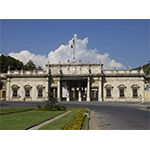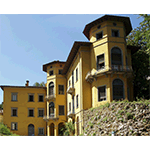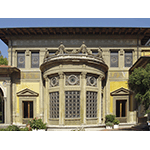Thermal baths in Tuscany

The link between thermal baths and scientific culture is evident in the discipline known as medical hydrology, the science that studies the therapeutical use of mineral waters. It was the physician Ugolino Caccini, better known as Ugolino da Montecatini, who compiled what can be considered the first treatise on medical hydrology – the Tractatus de Balneis – which he presented at Cittą di Castello in 1417.
Thermal baths and science
The itinerary through these very particular places of science and pleasure is especially attractive in Tuscany, a region that boasts many elegant thermal centres. Known since antiquity, the Tuscan baths flourished in the Middle Ages and again in Medicean times. It was however during the 18th century, under the rule of the Lorraines, that the baths became real businesses, of significant economic interest. Exploitation of the springs, promoted in particular by the governments of Francis Stephen and Peter Leopold, complied with the requisite of correct, rational administration of the territory.

Chemistry and thermal centres in the 18th century
The naturalist and physician Giovanni Targioni Tozzetti, charged by the grand-ducal government to explore the Tuscan territory, also made a census of the thermal baths. In his Relazioni di alcuni viaggi fatti in diverse parti della Toscana, he furnished a complete list of the thermal waters found in the region, relating their history and specifying their therapeutic properties.
The progress achieved in chemistry by the mid-eighteenth century was to prove essential for scientific investigations carried out with the support of new theories, new methods and new instruments. On this basis, the physical characteristics of the water from the springs were determined, evaluating their heat, odour and taste; analyses were conducted using particular reagents to determine their composition; and lastly, their therapeutic effects were evaluated, linking each type of water to the treatment of specific disorders. Water was, in fact, a valid natural cure for disease, considered by the medical science of the times to result from an alteration in the humours in the body. Due to its own particular qualities, water seemed able to restore equilibrium to an ailing organism.
In 1750 the physician Antonio Cocchi published an important treatise on the Baths of Pisa, and in 1788 the Florentine physician Alessandro Bicchierai published a significant work on the Baths of Montecatini. Dedicated to Grand Duke Peter Leopold, Bicchierai's work went beyond the purely descriptive tradition to present new methods of analysis linked to modern experimentation, thus constituting a model for the works of Giorgio Santi on the Baths of Pisa and Domenico Luigi Moscheni on the Baths of Lucca.

The most important centres in the Grand Duchy
During the Lorraine period the Baths of San Giuliano and those of Montecatini became the most important thermal stations in the Grand Duchy. The Baths of San Giuliano, not far from Pisa, were rebuilt in the first half of the 18th century, and soon became a fashionable place frequented by prominent Tuscan and foreign families. The Baths of Montecatini, rebuilt under the government of Peter Leopold, became quite famous in the second half of the 18th century, even beyond the boundaries of Tuscany. Another major thermal centre was Chianciano, whose mineral waters were the subject of important scientific treatises written by physicians and naturalists in both the 18th and the 19th century.

Thermal baths around Lucca
Outside the boundaries of the Grand Duchy is the ancient thermal centre of the Baths of Lucca, already known and frequented in antiquity. Under the government of Elisa Bonaparte Baciocchi, the Baths became one of the most famous thermal centres in Italy and abroad. Its "miraculous" waters attracted the greatest celebrities of the time.

Thermal baths in the 19th century
During the course of the 19th century, hydrology became a specific branch of the medical sciences. The thermal localities of Tuscany developed still further as health centres and resort towns: Bagni di Lucca, San Giuliano and Montecatini reached a height of splendour and became favourite places of sojourn in the cultured, refined nineteenth-century gran tour.
****************************
Texts by Graziano Magrini, Anna Toscano
English translation by Catherine Frost
Last update 12/feb/2008


